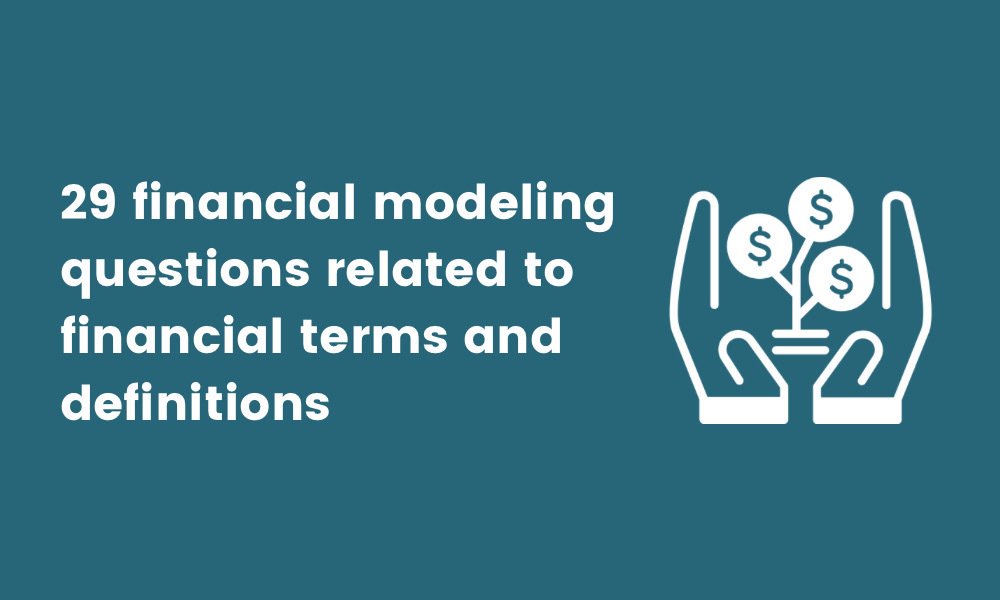55 financial modeling interview questions
Hiring a financial modeling expert with the right skills to meet your company’s fiscal challenges isn’t easy.
When it comes to the interview, you need a list of relevant interview questions to assess your candidates’ financial modeling skills.
But guess what?
Even if building your own list of questions can be tricky, this article will make the task much more manageable.
We’ve put together a list of 55 financial modeling interview questions to simplify the interviewing process and make hiring a professional easier.
Table of contents
- 15 general financial modeling interview questions
- 5 general financial modeling interview questions and answers
- 29 financial modeling questions related to financial terms and definitions
- 5 financial modeling questions and answers related to financial terms and definitions
- 11 behavioral financial modeling interview questions
- 5 behavioral financial modeling interview questions and answers
- 5 tips for using financial modeling interview questions
- Assess your candidates with these financial modeling interview questions
15 general financial modeling interview questions
Firstly, assess your candidates’ understanding of general financial modeling concepts with some of the following 15 questions.
What is financial modeling?
Which skills are required to be a successful financial modeling expert?
What are your greatest strengths related to financial modeling?
Why do companies use financial models?
How do you build a financial model?
Name three best practices for financial modeling.
Name three types of financial statements.
Name five types of financial ratios.
Which factors should you consider when recording PP&E?
Which financial concepts are essential for financial modeling?
Name three company valuation techniques.
Why do companies use deferred tax liabilities?
When would you use LOOKUP in financial modeling?
When would you use VLOOKUP in financial modeling?
Explain which Excel functions can slow down large financial model recalculations.
5 general financial modeling interview questions and answers
Here are five general financial modeling interview questions from the list above and the answers you might expect from your candidates.
1. Which skills are required to be a successful financial modeling expert?
Candidates may mention that attention to detail, accounting skills, problem-solving, communication skills, time management, and computing skills are all required to be an excellent financial modeling expert.
2. Name three best practices for financial modeling.
Three best practices for financial modeling include:
Using Excel efficiently and knowing how to use keyboard shortcuts and formulas
Implementing a logical design when structuring a financial model
Checking and double-checking the model to avoid any errors
3. What is financial modeling?
Financial modeling involves producing a summary of an enterprise’s expenses and earnings. Financial professionals create summaries using spreadsheets to work out how future decisions will impact the business.
4. Name three types of financial statements.
Three examples of financial statements that your candidates may mention include:
Balance sheets
Cash flow statements
Income statements
5. What are your greatest strengths related to financial modeling?
Answers to this question are likely to vary. For example, your candidates may mention their math skills as their greatest strength. Alternatively, they may note that they have exceptional attention to detail or top critical thinking skills.
What’s important is for your candidates to provide clear and suitable examples that demonstrate how their greatest strengths have helped them complete a task.
For example, they may explain that their attention to detail helped them spot an error in a financial model.
The best insights on HR and recruitment, delivered to your inbox.
Biweekly updates. No spam. Unsubscribe any time.
29 financial modeling questions related to financial terms and definitions
Ask your candidates the financial modeling questions listed in this section to determine if they have the required knowledge to perform well in your organization.
What does equity financing mean?
Explain what an income statement is.
What does DCG mean?
Explain what operating cash flow is.
Explain what the inventory turnover ratio means.
Explain what the return on equity ratio means.
Explain what an adjustment entry is.
What is the LIBOR rate?
Explain what preference capital is.
Explain what hedging means.
What does the FAST principle mean in financial modeling?
Explain what quarterly forecasting means
Explain what cost accountancy means.
What is debt financing?
Explain the role of a credit rating agency.
Explain what an investment is.
What is free cash flow?
Explain what debentures are.
Explain what an array function is.
What does NPV mean?
What does IRR mean?
Explain what XNVP means.
Explain what vertical analysis is.
Explain what horizontal analysis is.
Explain what sensitivity analysis is.
What is an expense model?
What is a P&L statement?
What is a balance sheet?
Explain the difference between NPV and XNPV
5 financial modeling questions and answers related to financial terms and definitions
Here are five questions about financial terms and definitions from the section above and the answers you should expect from your candidates.
1. What does the FAST principle mean in financial modeling?
FAST is an acronym used in financial modeling to outline the design principles that financial professionals should use to create sound financial models.
Flexibility: Financial professionals should be able to modify a financial model with ease.
Appropriate: A financial professional should include only the relevant details in a financial model.
Structure: The financial model structure should be structured logically and accommodate potential changes in authorship.
Transparent: Models should use clear and straightforward formulas so that financial professionals can use them.
2. Explain what free cash flow is.
Free cash flow is a phrase that refers to the cash that an enterprise generates once a business leader or an accountant has considered the outflows that support the business’ operations – any money left over when a company has paid operational and capital expenditures is free cash flow.
3. Explain what operating cash flow is.
Operating cash flow is a phrase that refers to the amount of cash an enterprise generates during normal business operations. Businesses with sufficient operational cash flow have enough to maintain operations and grow. Without it, the company may need external financing.
4. What is a balance sheet?
Balance sheets are financial statements in which financial professionals can find the liabilities, assets, and shareholder equity of an enterprise at a particular moment.
5. Explain what horizontal analysis is.
Horizontal analysis is what experts use to review financial statements and compare historical information over several accounting periods.
11 behavioral financial modeling interview questions
Ask your financial modeling candidates the questions in this section to determine how they would perform if hired for your open role.
How would you design revenue schedules?
How would you calculate working capital?
How would you make a debt forecast in your financial model?
What is the difference between a P&L statement and a balance sheet?
How would you audit a financial model using Excel?
Explain how you would perform a vertical analysis.
Describe a time when you made an incorrect financial forecast.
Which methods would you use to forecast revenues?
In which situation would you capitalize a purchase?
In which situation would you expense a purchase?
Which valuation tool would you use after preparing the financial model?
5 behavioral financial modeling interview questions and answers
Here are five behavioral financial modeling interview questions from the above section and the answers you should listen out for from your candidates.
1. Which methods would you use to forecast revenue?
Forecasting revenue is a critical indicator of a business’s financial performance. Candidates may acknowledge several ways to forecast revenue, including:
Straight-line methods, which measure the constant growth rate
Simple linear regression approaches, which compare an independent and a dependent variable
Moving average methods, which experts use to measure repeated forecasts
2. Describe a time when you made an incorrect financial forecast.
Each candidate will describe a different situation in which they made an incorrect financial forecast. Listen for responses that indicate that your candidates learned how to perfect the financial model selection process and note what they learned from the inaccurate forecast.
3. How would you make a debt forecast in your financial model?
Candidates should mention that a debt schedule is helpful in making a debt forecast. They may also note that the debt-to-equity ratio is a valuable metric when forecasting debt.
4. How would you calculate working capital?
Your candidates may explain that they would deduct the current liabilities from a business’s existing assets to calculate working capital, where these assets have been recorded over a period of time (typically over one year).
5. Explain how you would perform a vertical analysis.
To perform a vertical analysis, candidates may mention that they use the following formulas to help them:
To calculate the percentage for income statements: income statement item divided by the total sales, multiplied by 100.
To calculate the percentage for balance sheets: balance sheet item divided by the total assets (or liabilities), multiplied by 100.
Learn more: 51 behavioral interview questions for roles in finance (+ answers to look for)
5 tips for using financial modeling interview questions
Before we get to the end of the article, here are five tips for using financial modeling interview questions when hiring a candidate.
1. Ask candidates to complete a skills assessment before you use financial modeling interview questions
Use pre-employment skills assessments before any other phase of the hiring process after applicants respond to your job advertisement.
By making this the first thing you do, you can avoid a long resume screening process and make it easier to spot the applicants with the right financial modeling skills for your vacancy.
2. Build your list of interview questions by using the results of the skills assessment
Once your applicants have completed the skills assessments, look at the results. Note any skills that your candidates lack and any questions that your candidates struggle to answer.
Build your list of interview questions based on these topics to test your candidates thoroughly and find out more about their knowledge.
For example, if several of your candidates indicate a weakness in attention to detail, ask them an interview question about how they try to improve these skills.
Similarly, you can note the questions your candidates answered without problems and create a list of interview questions that dig deeper into those skills to find out how they take advantage of their strengths on the job.
3. Take notes during the interview and use a scoresheet
Use an interview scoresheet to help you take notes on your candidates’ responses. To do this, make sure you have written down a list of skills you need in your future employee. For each candidate, use the same scorecard template.
Here are three best practices for taking notes and using scorecards:
Make sure you create a precise scoring system
Always tell your candidates that you will be taking notes
Try to maintain eye contact when you record scores during the interview to avoid interrupting the flow
4. Inform candidates about their progress following the interview and provide feedback
Providing feedback can improve the candidate experience, so always inform your candidates about their progress. Even if it’s to give them disappointing news, keep candidates up to date.
One way to inform candidates that you haven’t selected them is to use the skills assessment results and notes from their interview to give them feedback. For example, if your candidate isn’t comfortable with simple linear regression methods, explain how they can improve.
5. Use the results of the interview for onboarding and training your new employee
When you have completed the interviews and chosen a candidate for the role, review the responses from the interview.
If you notice an area they need to improve on, create an onboarding checklist and training plan to build those skills.
Assess your candidates with these financial modeling interview questions
Finding financial modeling experts can be difficult, but a couple of simple tools will make it far easier to determine if your candidates have the right skills for the job. Make sure to use skills tests and financial modeling interview questions!
Don’t forget to invite candidates to complete a skills assessment as soon as you receive their application.
Start by visiting the TestGorilla skills test library to find appropriate tests, invite candidates, and then use the financial modeling interview questions to learn how proficient your candidates are.
Find the right expert for your team without difficulties and hire without complications with TestGorilla. Get started for free today.
You've scrolled this far
Why not try TestGorilla for free, and see what happens when you put skills first.






















